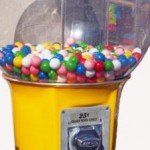Gumball Medicine
About 2 weeks ago I spoke at the LA County Office of Education. From there, my wife and I took a drive down the California coast. Along the way, we stopped off at the Huntington Beach Pier. It was a scene right out of a postcard: Sunny, temperature in the low 80’s, and humanity of all shapes and sizes out enjoying themselves: on the beach, in the water, or strolling along the pier. I suppose I’m strange, but in the midst of all the goings-on, I suddenly flashed back to my talk on ASD. The trigger for my flashback? A gumball machine. The giant dome was labeled “Magic Gumballs – 25 cents.” It struck me that a gumball machine is the perfect metaphor for DSM5: Put your quarter into the machine, and out pops a gumball. (I remember when they were 2 cents, but that’s another story.) Each gumball is a discrete entity, physically separate from all the others. Each gumball is brightly colored, and readily distinguishable from its fellows on that basis as well: There are red gumballs and blue gumballs and green gumballs and yellow gumballs. But (at least in this machine, and historically) there are no striped or polka-dotted or checkered gumballs. Just nice bright primary colors (although, I see that “pink” makes the list!). And so it is with DSM5: You put in your money, and out come one or more diagnoses – Each one fictitiously separate from all the others, as unique, non-overlapping entities.
Gumballs are so “Gay 90s,” right along with spats and parasols. (Gumballs were invented around 1890; the gumball machine was invented around 1907). The DSM traces its intellectual foundations back to the same era, and reflects the same mindset: Does your child have ASD and ADHD? ASD and a Mood Disorder? All three? What about Anxiety Disorder? For 25 cents apiece, you can have as many as you want. Oops, that’s gumballs, not diagnoses, but you get the idea. The brain, however, is not a Plexiglass sphere.
A better image for behavioral diagnosis (using the word “behavioral” in its broadest context, to include “developmental,” “psychiatric,” and “socially mediated” behaviors) would be a wad of gum that started out as several gumballs of different colors, after you’ve popped them all into your mouth and chewed on them for 30 seconds (No, I am not going to include a photo!). The first chew breaks through the outer shells of the individual balls; the next few chews cause the different colors to swirl together. As unappetizing as it may be, this “wad of gum” image is crucial to ensuring adequate care for all persons with ASD. Behaviorists ignore the psychiatric and developmental aspects, for example. Likewise, spokespersons for the autism community who tried to distance ASD from the Newtown shootings by asserting that although Adam Lanza may have had ASD, he “also” may have had a mental health disorder as if ASD and mental health were totally distinct and completely separate from one another.
Until the next time.
James Coplan, MD is an Internationally recognized clinician, author, and public speaker in the fields of early child development, early language development and autistic spectrum disorders.















Leave a Reply